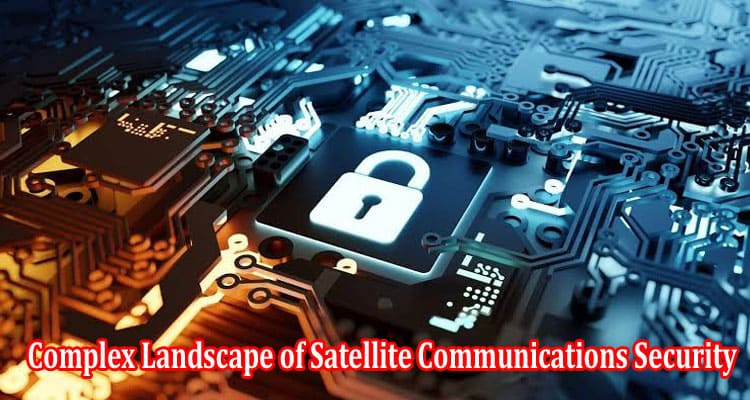Introduction
Satellite communications have become integral to our interconnected world and pivotal in global connectivity. This article explores the background, purpose, and scope of examining the vulnerabilities associated with satellite communications.
Background
With the advancement of technology, satellite communications have become a linchpin in various sectors, including telecommunications, broadcasting, and military applications. The reliance on satellites for critical communication demands a comprehensive understanding of potential vulnerabilities that may compromise the integrity of these systems.
Purpose of the Document
The primary purpose of this document is to shed light on the security challenges surrounding satellite communications. By identifying and analyzing these vulnerabilities, we aim to contribute to the development of robust strategies for safeguarding satellite-based infrastructures. This document serves as a resource for stakeholders in the satellite industry, policymakers, and cybersecurity professionals.
Scope and Limitations
The scope of this examination encompasses the entire lifecycle of satellite communications, from design and construction to operational use. It delves into both technical and non-technical aspects of security concerns. However, it’s important to note that the rapidly evolving landscape of technology and cybersecurity introduces limitations in providing exhaustive insights, and the document may only encompass some emerging threats or solutions.
Satellite Communications Overview
Basics of Satellite Communications
Satellite communications involve the transmission of data through satellites orbiting the Earth. This section provides a foundational understanding of how satellites facilitate communication across vast distances, highlighting key concepts such as uplink and downlink transmissions.
Importance and Ubiquity
Examining satellites’ pivotal role in various sectors, including telecommunications, weather forecasting, and global positioning systems (GPS). The ubiquity of satellite technology in everyday life underscores the critical need to address potential vulnerabilities.
Key Components and Infrastructure
A comprehensive overview of satellite communication systems, including ground stations, transponders, and satellite networks, is essential for practical security risk assessment and management.
Security Concerns in Satellite Communications
Cybersecurity Threats
Satellite communications face a significant challenge from a growing array of cybersecurity threats. These include risks like data manipulation and unauthorized access, posing threats to communication confidentiality and integrity. Adversaries may exploit vulnerabilities in satellite networks, putting the secure transmission of sensitive information at risk. Analyzing these threats is vital for developing robust cybersecurity measures to protect satellite communication systems.
Physical Vulnerabilities
Beyond cyber threats, the physical infrastructure of satellite communications introduces additional vulnerabilities. Satellites, ground stations, and associated equipment are at risk from space debris, natural disasters, and physical tampering. Space debris, including defunct satellites and fragments, poses a collision risk, while natural disasters like solar flares can disrupt satellite operations. Unauthorized access and intentional damage to satellite components further threaten the reliability and functionality of satellite communication systems.
Spectrum Interference
Satellite communications are susceptible to spectrum interference, encompassing intentional jamming and unintentional frequency clashes. Deliberate interference aims to disrupt communications or gain a strategic advantage, while unintended clashes result from the crowded electromagnetic spectrum. Both scenarios can lead to signal degradation and potential disruptions. Mitigating the impact of spectrum interference is crucial for maintaining signal quality and overall system reliability in the design and operation of satellite communication systems.
Recent Incidents and Case Studies
Notable Security Breaches
Examining recent incidents involving security breaches in satellite communications provides valuable insights into the evolving threat landscape. Case studies may include unauthorized access, data breaches, or deliberate interference with satellite signals. Analyzing the specifics of these incidents helps understand vulnerabilities and improve security measures.
Lessons Learned
Every security breach offers an opportunity to learn and strengthen defenses. This section explores the lessons learned from past incidents. It might include insights about the effectiveness of response techniques, gaps in security measures, and the significance of continuous monitoring and adaptation in the face of increasing threats.
Regulatory Framework
International Regulations
Satellite communications operate in a global context, necessitating international cooperation and standards. This section delves into the international regulatory framework governing satellite communications. Organizations such as the International Telecommunication Union (ITU) and international treaties play a crucial role in establishing guidelines for the responsible and secure use of satellite technology.
National Security Measures
National governments also implement regulations to safeguard satellite communications within their borders. This may involve legislation addressing cybersecurity, data protection, and national security concerns related to satellite infrastructure. Examining national security measures provides a comprehensive view of the legal and regulatory landscape influencing satellite communication security.
Compliance Standards
Compliance with established standards is essential for ensuring the security and reliability of satellite communications. This section explores industry-specific standards and best practices that organizations must adhere to. Compliance standards may cover encryption protocols, access controls, and incident response planning. Understanding and meeting these standards are critical components of a robust security posture.
Mitigation Strategies
Encryption and Authentication
Implementing robust encryption and authentication mechanisms is paramount to securing satellite communications. Encryption ensures that transmitted data remains confidential and cannot be easily intercepted or tampered with. Authentication protocols verify the legitimacy of users and devices, preventing unauthorized access. This section explores advanced encryption algorithms, secure key management, and authentication best practices specific to satellite communication systems.
Satellite Security Protocols
Developing and implementing security protocols tailored to the unique characteristics of satellite communications is essential. This involves defining standards for secure data transmission, access controls, and network integrity. Examining established security protocols, such as those addressing communication between ground stations and satellites, helps identify best practices for mitigating cyber threats.
Physical Security Measures
Beyond cyber threats, safeguarding the physical infrastructure of satellite systems is crucial. This section explores measures such as secure satellite ground station facilities, tamper-resistant hardware, and protection against environmental hazards. Physical security measures are required to prevent unwanted entry, tampering, and disturbances caused by severe weather.
In the 21st century, computers are integral to daily life, emphasizing the need for robust cyber security. As technology advances, so do cyber threats, putting sensitive business and personal data at risk. Cybersecurity involves strategies and technologies to protect systems from unauthorized access, malware, and other threats. Organizations and individuals must prioritize cybersecurity by staying informed, updating software, and fostering a culture of awareness. Governments, businesses, and individuals should collaborate to establish comprehensive cybersecurity frameworks and regulations. The role of cybersecurity will only grow more critical with advancing technology. For implementing cybersecurity, you need a reliable partner to ensure robust protection. You can find best reliable partner from from Yelp.com, YellowPages.com or HeadquarterLocation.com
Future Trends and Technologies:
The fast-evolving technological landscape is set to bring about transformational improvements in various domains, including satellite security. As we look ahead, several trends and technologies are expected to shape the future of satellite security.
Quantum Cryptography: With the increasing sophistication of cyber threats, the adoption of quantum cryptography is anticipated to become a crucial aspect of satellite communication security. The quantum key distribution offers a theoretically unbreakable method for securing communication channels, providing enhanced protection against potential adversaries.
Blockchain for Satellite Communication: Blockchain technology’s decentralized and tamper-resistant nature holds promise for ensuring the integrity and security of satellite data transmissions. Blockchain can be leveraged to establish transparent and secure communication channels, reducing the risk of unauthorized access and data manipulation.
Space-Based Cybersecurity Operations: Dedicated space-based cybersecurity operations will likely emerge as satellites become more interconnected and reliant on data exchange. These operations will involve real-time monitoring, threat detection, and response mechanisms to safeguard satellite networks from evolving cyber threats.
Edge Computing for Satellite Systems: The integration of edge computing in satellite systems enables data processing closer to the source, reducing latency and enhancing overall system efficiency. This shift towards edge computing can also contribute to improved security by minimizing the exposure of sensitive data during transit.
Artificial Intelligence (AI) for Threat Prediction: AI-driven threat intelligence is expected to play a pivotal role in anticipating and mitigating security risks. Machine learning algorithms will scan massive volumes of data to discover trends, detect abnormalities, and forecast future threats to satellite networks, allowing proactive security measures to be implemented.
5G Integration with Satellite Communication: The integration of 5G technology with satellite communication will enhance data transfer speeds and introduce new security protocols. This synergy will be crucial for supporting emerging applications, such as IoT devices in space, and will require robust security measures to protect sensitive data.
Autonomous Security Systems: The development of autonomous security systems powered by advanced AI algorithms will enable satellites to adapt and respond to security threats in real time. These systems can autonomously detect and neutralize potential risks, reducing the dependence on manual intervention and minimizing response times.
Collaborative Space Security Initiatives: As the space domain becomes more contested, collaborative efforts among nations and private entities will be essential for enhancing overall space security. Shared threat intelligence, joint research, and coordinated responses to cyber threats will characterize future collaborations in safeguarding satellite systems.
Conclusion
Summary of Key Findings
Summarizing the document’s key findings provides a concise overview of the vulnerabilities, incidents, and mitigation strategies discussed. This section distills the essential insights gained from examining the security landscape of satellite communications, highlighting crucial takeaways for stakeholders.
Recommendations for Enhanced Security
Based on the identified vulnerabilities and mitigation strategies, this section offers concrete recommendations for enhancing the security of satellite communications. These recommendations may include technical measures, policy changes, and industry collaboration to address current and potential future threats effectively.




